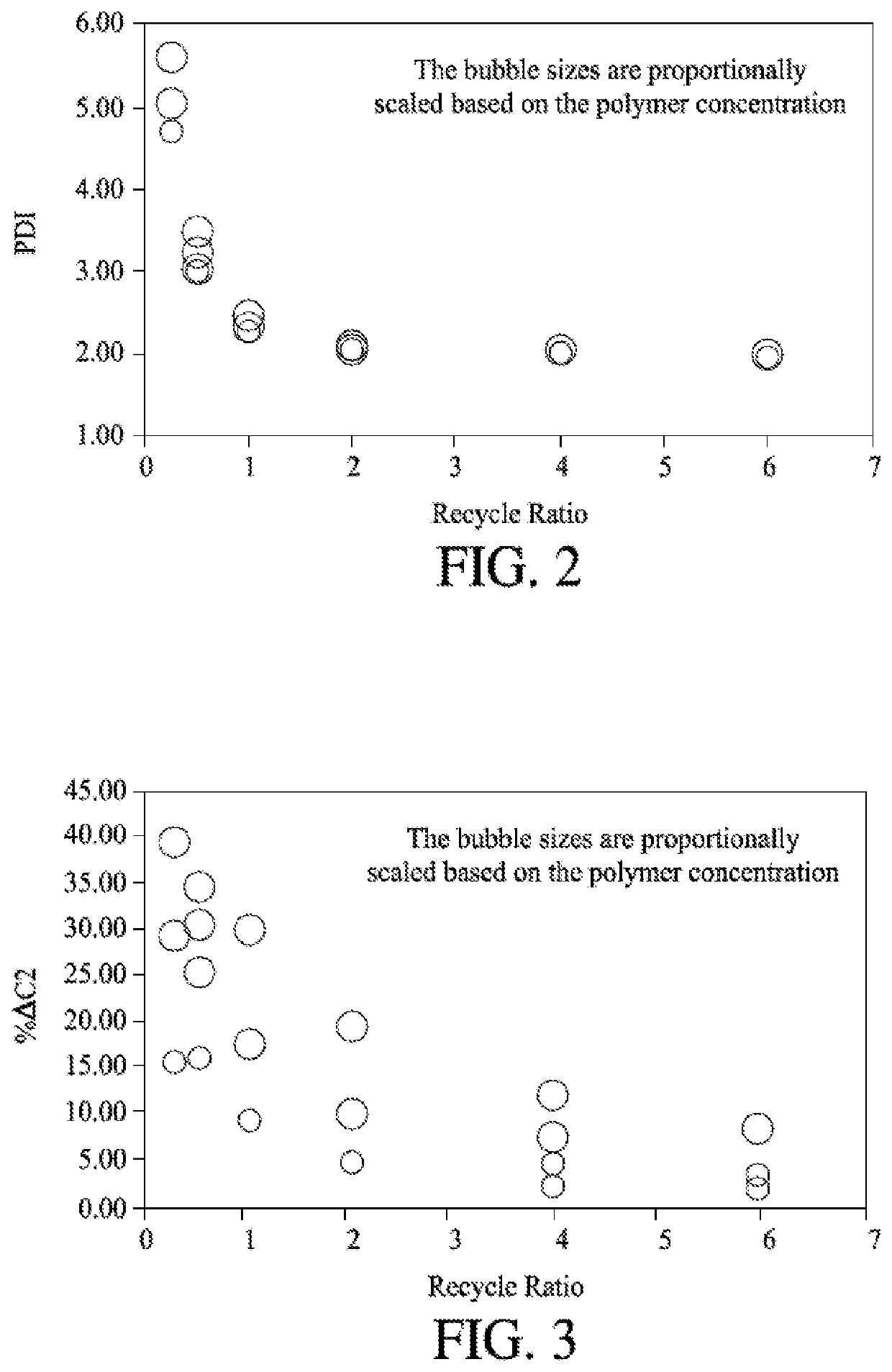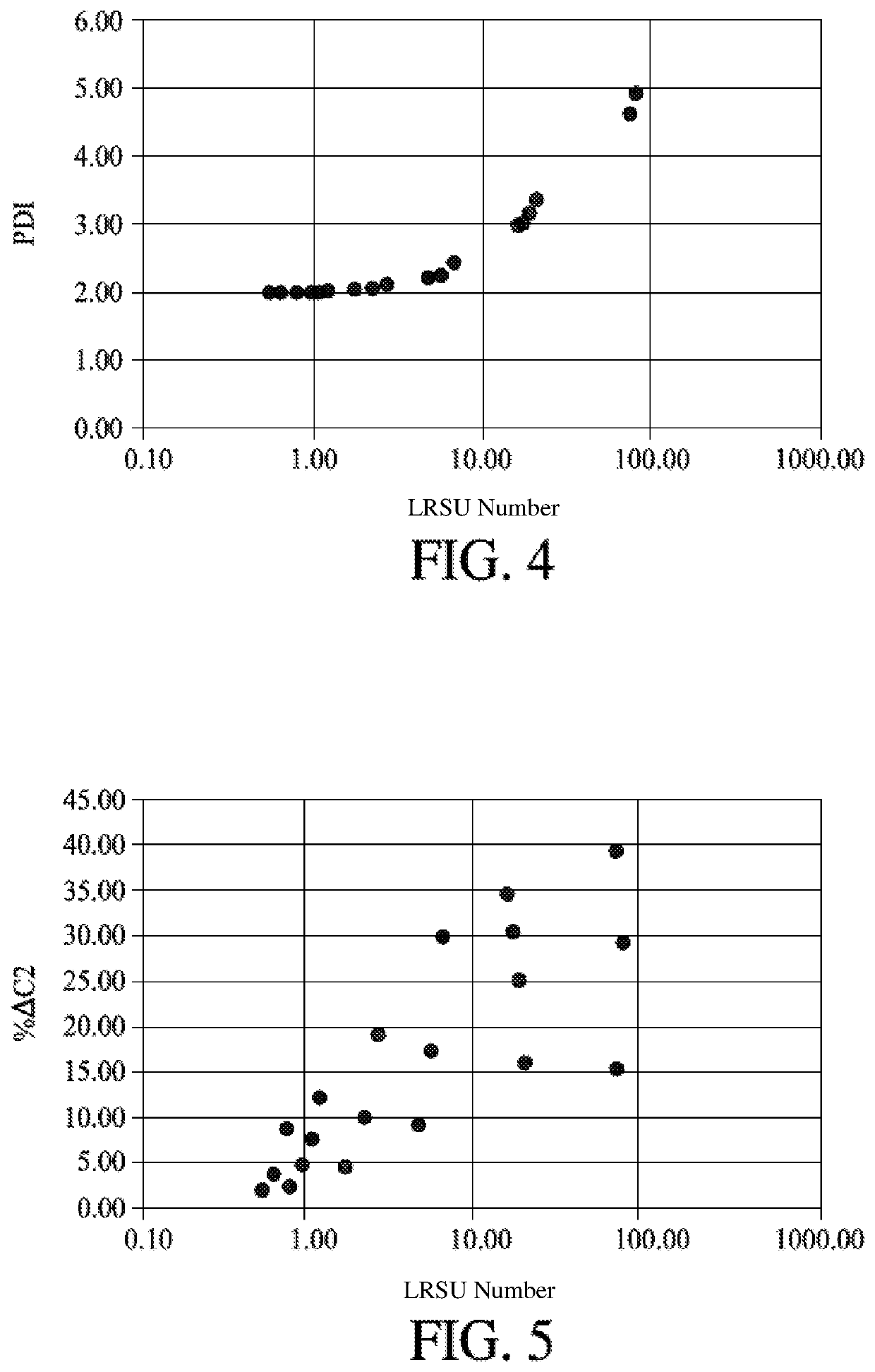Controlling Molecular Weight Distribution and Chemical Composition Distribution of a Polyolefin Product
- Summary
- Abstract
- Description
- Claims
- Application Information
AI Technical Summary
Benefits of technology
Problems solved by technology
Method used
Image
Examples
example embodiments
[0058]A first example embodiment is a method comprising: polymerizing a feedstock in the presence of a metallocene catalyst in a loop reactor to produce a polyolefin product, the feedstock comprising two or more monomers; and broadening a molecular weight distribution and / or broadening a chemical composition distribution of the polyolefin product by adjusting a polymerization parameter selected from the group consisting of decreasing a recycle ratio, increasing a polymer concentration, increasing a LRSU number, and any combination thereof. Optionally this method can further include one or more of the following: Element 1: wherein the a first of the two or more monomers is selected from the group consisting of: ethylene, propylene, butene, pentene, hexene, heptene, octene, nonene, decene, dodecene, 4-methylpentene-1,3-methylpentene-1,3,5,5-trimethylhexene-1, and 5-ethylnonene-1; Element 2: Element 1 and wherein a second of the two or more monomers is different than the first and is s...
example 1
[0064]A polymerization reaction was simulated with varied polymerization parameters of recycle ratio and polymer concentration. The simulation software used was Aspen Plus version 8.8 with the Aspen Polymer Module. The thermodynamic method is based on Perturbed-Chain Statistical Association Fluid Theory (PC-SAFT). The required material properties were directly obtained from the property data banks implemented in Aspen Plus. Plug flow reactors were used to simulate the heat exchangers and loop lines in the loop reactor. The heat exchangers were set to be in isothermal mode while the loop lines were treated adiabatically.
[0065]The reaction simulated in the example was copolymerization of ethylene and propylene. Copolymerization kinetics were obtained from the literature and implemented in the simulator. Therefore, both heat and mass balance and polymer properties, including chemical composition and molecular weight distribution can be accurately modeled. A metallocene catalyst was use...
example 2
[0069]A polymerization reaction was simulated with varied polymerization parameter values for the Loop Reactor Scale-Up number (LRSU). As with Example 1, the simulation software used was Aspen Plus version 8.8 with the Aspen Polymer Module except the weight fraction ratio of ethylene monomer:propylene monomer:solvent was set to be 4.2%:33.7%:62.1%. Because propylene is the major monomer in the feedstock, the LRSU is based on propylene. The LRSU number was adjusted between 0.55 and 81.05. FIG. 4 is the PDI as a function of Da. FIG. 5 is the %ΔC2 as a function of Da. Table 2 is the data represented in the figures.
TABLE 2CaseLRSUPDI% ΔC210.552.011.9520.652.013.6730.782.028.8540.812.012.3950.972.024.8461.102.027.5971.222.0412.1581.742.054.5992.242.0710.06102.742.1319.27114.752.239.22125.762.2817.50136.712.4429.941416.243.0034.741517.373.0430.511619.083.1825.341720.763.3816.181873.354.0239.421974.634.6515.612081.054.9529.42
[0070]This example illustrates that generally increasing the LRSU...
PUM
| Property | Measurement | Unit |
|---|---|---|
| Temperature | aaaaa | aaaaa |
| Temperature | aaaaa | aaaaa |
| Temperature | aaaaa | aaaaa |
Abstract
Description
Claims
Application Information
 Login to View More
Login to View More - R&D
- Intellectual Property
- Life Sciences
- Materials
- Tech Scout
- Unparalleled Data Quality
- Higher Quality Content
- 60% Fewer Hallucinations
Browse by: Latest US Patents, China's latest patents, Technical Efficacy Thesaurus, Application Domain, Technology Topic, Popular Technical Reports.
© 2025 PatSnap. All rights reserved.Legal|Privacy policy|Modern Slavery Act Transparency Statement|Sitemap|About US| Contact US: help@patsnap.com



